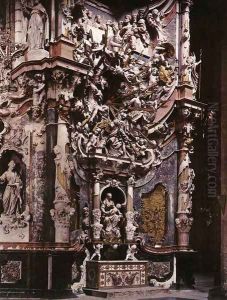Narcisco Tome Paintings
Narciso Tomé was a Spanish architect and sculptor of the late Baroque or Rococo period, best known for his work on the Transparente of Toledo Cathedral. Born in 1670 in Toro, a small town in the province of Zamora, Castile and León, Spain, Tomé was part of a family of architects and sculptors, which included his father, Diego Tomé, and his brothers, Diego and José Tomé. His family's artistic background provided him with an environment conducive to developing his skills in the arts from a young age.
Initially, Narciso Tomé worked in Valladolid, but his career reached its zenith in Toledo, where he was appointed as the master architect of Toledo Cathedral in 1721. Tomé's most celebrated work is the Transparente, an altarpiece of the cathedral designed to allow light to pass through it, hence the name. Completed in 1732, the Transparente is a masterful blending of sculpture, painting, and architecture that creates a stunningly dramatic effect of light and shadow, which was intended to symbolize the Heavenly Jerusalem.
The Transparente is also noted for its elaborate use of stucco, painting, bronze, and marble, integrating complex iconography and theological symbolism. Tomé employed a high degree of technical innovation in its construction, including the strategic positioning of a hole in the roof, which allows natural light to illuminate the altarpiece in a unique way. This feature was particularly avant-garde for its time and is considered a masterpiece of Spanish Baroque art.
Beyond the Transparente, Narciso Tomé's works include various other projects, such as the retablo (altarpiece) for the Church of Saint Augustine in Salamanca and the main altar for the Church of Saint Millán in Segovia. His architectural and sculptural style is characterized by dynamic forms, an emphasis on light effects, and a preference for dramatic expressiveness.
Narciso Tomé's contributions to Spanish art were significant during the early 18th century, and his works continue to be studied and admired for their artistic and technical accomplishments. His legacy is also carried on through the works of his son, Diego Tomé, who was also an accomplished architect and sculptor. Narciso Tomé passed away in 1742, leaving behind a body of work that remains influential in the study of Spanish Baroque art.
